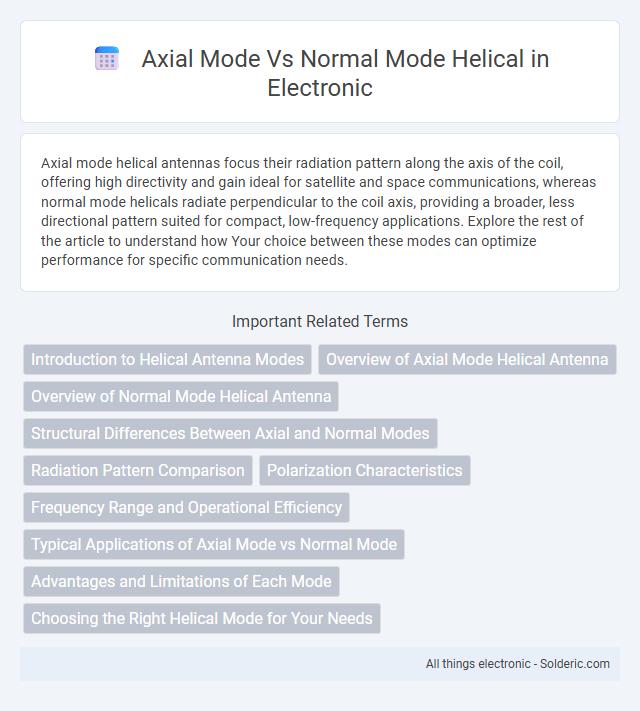Axial mode helical antennas focus their radiation pattern along the axis of the coil, offering high directivity and gain ideal for satellite and space communications, whereas normal mode helicals radiate perpendicular to the coil axis, providing a broader, less directional pattern suited for compact, low-frequency applications. Explore the rest of the article to understand how Your choice between these modes can optimize performance for specific communication needs.
Comparison Table
| Feature | Axial Mode Helical | Normal Mode Helical |
|---|---|---|
| Radiation Pattern | Highly directional, narrow beam | Omnidirectional or broad beam |
| Operating Mode | Axial mode (waves travel along helix axis) | Normal mode (waves resonate around helix circumference) |
| Gain | High gain (typically 12-15 dBi) | Low gain (usually 0-6 dBi) |
| Polarization | Circular polarization (RHCP or LHCP) | Linear polarization |
| Axial Ratio | Close to 1 (better circular polarization) | Higher than 1 (poor circular polarization) |
| Number of Turns | Many turns (typically > 3) | Few turns (usually 1-3) |
| Applications | Satellite communication, radar, GPS | Receiving antennas, portable radios |
Introduction to Helical Antenna Modes
Helical antennas operate primarily in two modes: axial mode and normal mode, each defined by the antenna's geometry and the wavelength relative to the helix circumference. Axial mode helical antennas produce circularly polarized radiation with a directional beam along the helix axis, making them ideal for satellite and space communication. Normal mode antennas radiate perpendicular to the helix axis with linear polarization and are generally used for compact, low-gain applications in your wireless systems.
Overview of Axial Mode Helical Antenna
Axial mode helical antennas operate with radiation directed along the antenna's axis, producing circularly polarized waves ideal for satellite and space communications. These antennas feature a helical conductor with specific pitch and diameter dimensions that determine the resonance at axial mode, typically providing high gain and wide bandwidth. The design contrasts with normal mode helicals, which radiate perpendicularly to the helix axis with lower gain and typically linear polarization.
Overview of Normal Mode Helical Antenna
Normal mode helical antennas operate with the helix diameter much smaller than the wavelength, resulting in an omnidirectional radiation pattern primarily along the helix axis. These antennas are typically used for lower frequency applications where compact size and wide bandwidth are essential. Your choice of a normal mode helical antenna benefits from simple construction and consistent circular polarization, ideal for applications like satellite communication and VHF transmission.
Structural Differences Between Axial and Normal Modes
Axial mode helical antennas feature a helix circumference approximately equal to the wavelength, producing a directional, circularly polarized beam along the antenna's axis, while normal mode helicals have much smaller circumferences, resulting in an omnidirectional radiation pattern perpendicular to the helix. The axial mode typically requires several turns and a larger pitch angle to maintain phase coherence and efficient radiation along the axis, whereas normal mode helicals have fewer turns with tighter coils, emphasizing compactness and simplicity. Understanding these structural differences allows you to select the appropriate helical antenna for applications requiring either directional gain or broad coverage.
Radiation Pattern Comparison
Axial mode helical antennas produce a highly directional radiation pattern with a narrow beamwidth along the antenna's axis, making them ideal for long-distance communication and satellite links. Normal mode helical antennas emit an omnidirectional, broad radiation pattern perpendicular to the antenna axis, suitable for local area coverage and mobile applications. Your choice depends on whether you prioritize directional gain or wide coverage in the radiation pattern.
Polarization Characteristics
Axial mode helical antennas produce circular polarization, which is ideal for maintaining signal integrity regardless of orientation, making them suitable for satellite and space communication. Normal mode helical antennas exhibit linear polarization, resulting in a more directional and polarized signal best used for terrestrial applications. Understanding the polarization characteristics of axial mode versus normal mode helical antennas helps you select the right antenna for your specific communication needs.
Frequency Range and Operational Efficiency
Axial mode helical antennas operate efficiently at higher frequency ranges, typically from VHF to GHz, offering a narrow beamwidth and increased gain, making them ideal for directional communication. Normal mode helical antennas function best at lower frequencies, often in the HF band, providing omnidirectional patterns with moderate efficiency suitable for broad coverage. Your choice depends on the required frequency band and whether you prioritize focused transmission or wide-area signal distribution.
Typical Applications of Axial Mode vs Normal Mode
Axial mode helical antennas are typically used in satellite communication and GPS systems due to their high gain and circular polarization, which enhances signal reception and transmission over long distances. Normal mode helical antennas find applications in VHF and UHF communication, RFID systems, and portable radios, where omnidirectional patterns and compact size are essential. Your choice depends on whether you need directional communication with higher gain or broad area coverage with lower gain.
Advantages and Limitations of Each Mode
Axial mode helical antennas offer high directional gain and narrow beamwidth, making them ideal for satellite communications and point-to-point links but suffer from complex manufacturing and larger size. Normal mode helical antennas provide omnidirectional radiation and simpler construction, suitable for VHF/UHF applications and mobile communications, yet they have lower gain and less directivity. The choice between axial and normal mode depends on the specific requirements for gain, bandwidth, size, and radiation pattern in communication systems.
Choosing the Right Helical Mode for Your Needs
Axial mode helical antennas provide highly directional radiation patterns ideal for long-distance communication and satellite applications, while normal mode helicals offer broader coverage with lower gain suitable for local or omnidirectional use. Your choice depends on whether you prioritize signal focus and gain (axial mode) or wider area coverage and simplicity (normal mode). Understanding these differences ensures optimized performance tailored to your specific communication requirements.
axial mode vs normal mode helical Infographic

 solderic.com
solderic.com